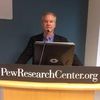A sense of urgency propels aging Pope Benedict in his upcoming trip to Mexico and Cuba. In both countries the pope will encounter increasingly diverse religious landscapes. This is especially the case in Cuba, where both Pentecostalism and the two main Afro-Cuban religions, Santeria and Palo Monte, have been flourishing since the last papal visit, John Paul's in 1998. While the Catholic church in Cuba has played an important role in promoting humans rights and negotiating the release of political prisoners, it has been losing ground in the competition for the souls of Cuba. Fierce competition with Pentecostalism and other religions, to a lesser extent, is a Latin America-wide phenomenon, but Cuba joins Brazil, Guatemala and a few other countries of the region as nations where active Catholics no longer constitute the majority of the population. Brazil, home to the world's largest Catholic and Pentecostal populations, is the only Latin American country that Benedict has visited to date. Thus, the Americas, home to half the world's Catholics, are of utmost concern to the Vatican. The future of the global church lies here.
Of particular significance in Cuba, is the pope's participation in the commemoration of the quadricentennial of the Virgin of Cobre, the national patron saint. Along with the pope, the Virgin Mary, in her various national and regional advocations, is one of the two premier symbols of Latin American Catholicism and stands at the vanguard of current evangelization efforts targeting "soft Catholics" who are seen as vulnerable sheep to the "rapacious wolves of Protestantism," to use an oft-cited phrase of John Paul II. So the issue in Cuba isn't so much religious freedom per se, which has increased since the last papal visit, but concern over the proliferation of Pentecostalism and Afro-Cuban religion partly at the expense of the Catholic Church.
The pope will also find an increasingly pluralist religious landscape in Mexico, but not as diverse as in Cuba. Pentecostalism has grown impressively since the 1970s, especially among indigenous groups. At least a third of the population of Chiapas, the state with the largest percentage of indigenous residents, are Protestant, mostly Pentecostal. Benedict XVI, however, will visit the country's most Catholic state, Guanajuato, and its largest city Leon, the seat of conservative Catholicism, led by Archbishop José Guadalupe Martín Rábago, who has been one of the church's most outspoken opponents of the mushrooming cult of Santa Muerte (Saint Death). This is a church facing significant competition from Pentecostals, neo-Christians, such as Mormons and Jehovah's Witnesses, and even "heretical" folks saints, such as Santa Muerte and Jesus Malverde. In addition, the Church has been rocked by the same type of sex-abuse scandals that have made headlines in Europe and here in the U.S.
On the political front, the timing of the pope's visit to Guanajuato is no coincidence. Both presidential and legislative elections will be held in July. The pro-Church political party, the PAN (National Action Party) has ruled the country for the past 12 years, and its presidential candidate Josefina Vasquez Mota trails PRI (Institutional Revolutionary Party) nominee Enrique Peña Nieto in the latest polls by six percentage points. Vasquez Mota has been steadily gaining ground on the PRI candidate over the past few months, and her campaign could potentially benefit from the papal visit to the Mexican state that is the most Catholic and PANista. Beginning with former president Vicente Fox, the center-right party has held the governorship in this geographically central state since 1991.
Founded by conservative Catholics in 1939, the PAN shares the Church's position on social issues, such as abortion and same-sex unions. Mexico City in 2010 became the largest city in a Catholic-majority country to legalize same sex unions and allow such couples to adopt children. Most ominously for the Church and PAN, the Mexican Supreme Court ruled at the end of 2010 that all of the country's 31 states must recognize same-sex marriages performed in the nation's capital. While the Vatican has asserted that Benedict is bypassing Mexico City because of the possibility of altitude sickness at the mile and half high city, the largest metropolis of the Americas seems increasingly less hospitable to the institutional Church.
Among two of the most dynamic religious practices in the Mexican megalopolis are the cults of Saint Jude, patron of lost causes, and Santa Muerte. Centered in the notorious barrio of Tepito, devotion to Saint Death takes place beyond the pale of the Church. Just a few miles away, the Church of Saint Hippolyte draws tens of thousands of devotees to its monthly celebrations of Saint Jude, who shares Santa Muerte's devotional base of marginalized youth. In contrast in Guanajuato, which has escaped much of the drug-related violence that plagues large swaths of the country, the pope will be greeted by the likes of my brother-in-law in Leon, an engineer and ardent PANista. Francisco says he is looking forward to "the pope's pro-life message, which we so need to hear in Mexico in midst of the culture of death that has permeated the country." Between the culture of death fostered by the interminable hemispheric drug wars and fierce religious competition throughout the region, Pope Benedict keenly perceives the present moment as "a precious time to evangelize in Latin America and the Caribbean."
Here's a look at the religious landscape of Mexico:

